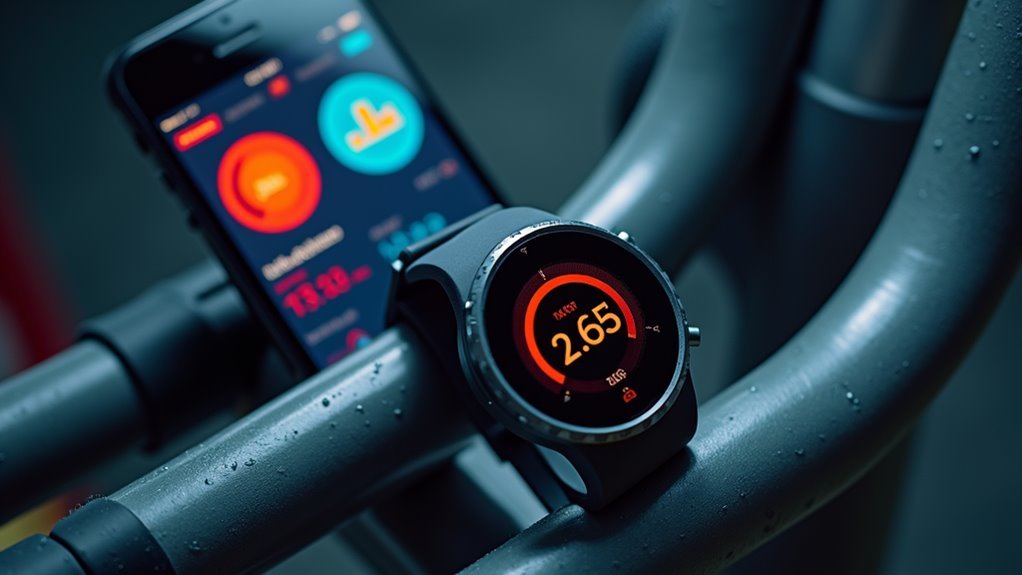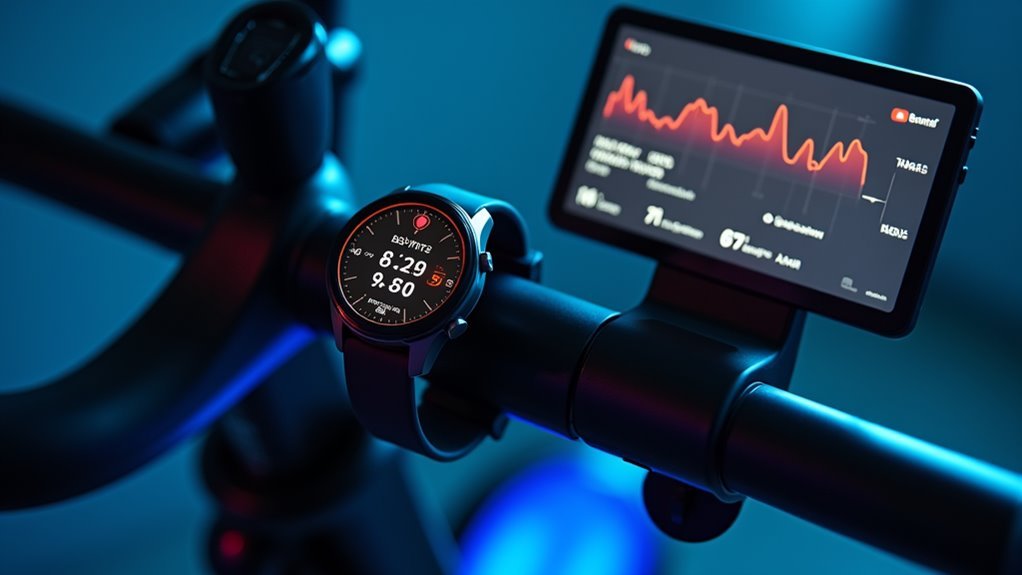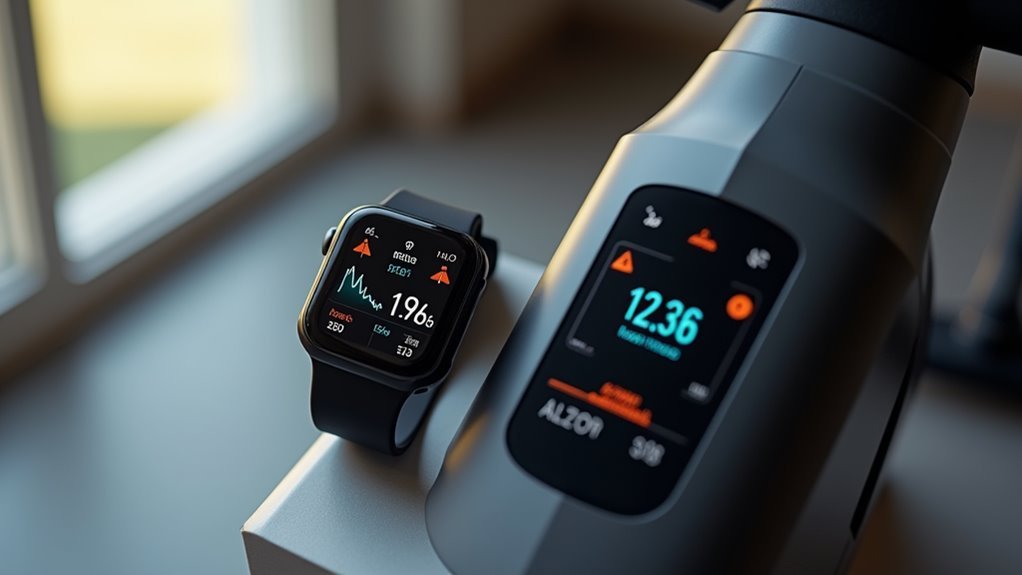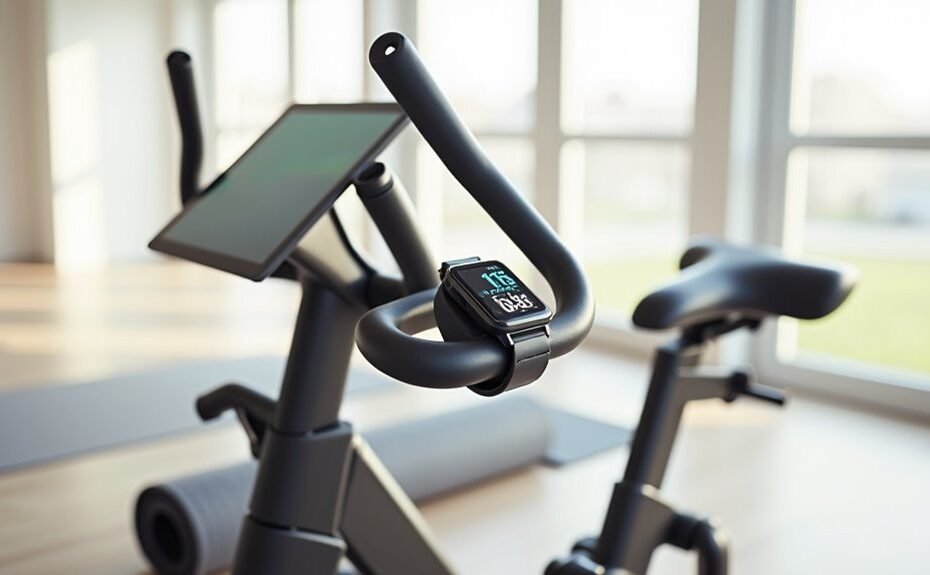During my first ride with a Peloton bike, I noticed how seamlessly my Apple Watch connected to track my heart rate, calories burned, and performance metrics. Today's exercise bikes have evolved far beyond standalone equipment, becoming central hubs in our digital fitness routines. I'll show you how to maximize your workout experience by connecting your favorite wearables and apps to your exercise bike, creating a personalized ecosystem that not only tracks your progress but keeps you motivated through data-driven insights and social connectivity.
Key Takeaways
- Exercise bikes support Bluetooth and ANT+ protocols to connect with popular wearables like Apple Watch, Fitbit, and Garmin devices.
- Real-time data syncing allows instant tracking of heart rate, calories burned, and performance metrics across connected fitness platforms.
- Compatible fitness apps like Strava, Apple Health, and Google Fit enable comprehensive workout data management and progress tracking.
- GymKit integration with Apple Watch provides two-way data synchronization for accurate workout metrics and performance monitoring.
- Wearables can connect directly to exercise bikes or through fitness apps, creating a seamless digital ecosystem for tracking fitness goals.
Smart Watch Connectivity Options
Modern smartwatches pack in multiple connectivity options to enhance your fitness tracking experience. I'll help you understand the two main protocols you'll encounter: Bluetooth and ANT+. While Bluetooth comes standard in most watches, ANT+ is typically found in higher-end models designed for serious athletes.
Bluetooth serves as your primary connection method, letting you sync with heart rate monitors, speed sensors, and power meters. I find it especially useful for connecting to your phone, enabling features like live tracking and notification display during workouts. Direct WiFi syncing eliminates the need to rely on your smartphone for uploading activities. The advanced tracking capabilities ensure accurate performance metrics for a more effective training experience.
You'll also use Bluetooth to sync your rides and customize your activity modes.
If you're using specific power meters like SRM or Quarq, you'll want a watch with ANT+ capability. This protocol is particularly important for connecting to indoor cycling equipment through the FE-C (Fitness Equipment Control) profile.
I recommend checking your smart bike or trainer's compatibility before choosing a watch, as some equipment only works with ANT+ and doesn't support Bluetooth alternatives like FTMS.
Heart Rate Monitor Integration
Integrating heart rate monitors into your fitness routine releases powerful training enhancement features.
When connected to exercise bikes like the VRAi Fitness SB1000X, these monitors provide real-time data that helps you maintain peak workout intensity. The Schwinn IC4 bike compatibility ensures seamless heart rate tracking during workouts. I've found that tracking heart rate zones guarantees you're training efficiently, whether your goal is endurance, strength, or speed improvement. With its LCD display, the VRAi's console clearly shows your pulse readings alongside other key workout metrics.
The integration of heart rate monitoring with exercise bikes transforms your workout experience through precise zone training. You'll get immediate feedback on your console display, allowing you to adjust your effort level instantly.
With Bluetooth connectivity, I can sync this data to my smartphone, making it easier to analyze my performance trends over time.
Here are three key benefits you'll experience with heart rate monitor integration:
- Personalized training intensity based on your body's actual response
- Reduced risk of overtraining through accurate heart rate zone monitoring
- Enhanced workout effectiveness with real-time performance feedback
Fitness App Data Synchronization

Seamless data synchronization between fitness apps enhances your workout tracking experience on TRUE Fitness equipment. I'll guide you through connecting your favorite fitness apps to maximize your workout data's potential.
You can sync your TRUE Fitness workouts with popular platforms like iFIT, which connects to Strava, Apple Health, Garmin Connect, and Google Fit. To start syncing, open your iFIT app, navigate to Settings, select "Connected apps," and choose which platforms you'd like to connect. Once authorized, your workout data will sync in real-time. Apps like Wahoo SYSTM offer comprehensive off-bike training features to complement your indoor cycling routine.
I recommend being selective about which apps you sync to avoid duplicate data entries. For example, if you're primarily a runner or cyclist, connecting to Strava might be your priority. Motivation and engagement increase significantly when using multiple integrated fitness apps.
If you're using an Apple Watch, you'll benefit from GymKit-enabled TRUE Fitness equipment, which provides two-way synchronization of metrics like heart rate and calories burned.
Remember that while syncing across platforms is convenient, you might notice slight variations in data interpretation between apps. If you need to disconnect any apps, you won't lose your workout history – it'll remain stored in the original recording application.
Real-Time Performance Tracking Features

Beyond app synchronization, TRUE Fitness equipment offers precise real-time performance tracking that transforms your workout experience.
Through professional-grade sensors and advanced monitoring systems, I can assure you that you'll get accuracy within ±1% for critical metrics like power output, heart rate, and calories burned. The double-sided velcro mounts ensure sensors stay firmly in place during intense workouts.
The 11-inch smart display shows your real-time progress, while integrated testing features like AI-adjusted ramp tests help measure and improve your aerobic performance. The system's AI-calibrated personalized rides adapt to your fitness level for optimal results.
You'll benefit from extensive data analysis through platforms like Cycling Analytics, where I track your training load, power history, and time spent in different intensity zones.
The equipment seamlessly connects with popular sensors from Garmin and Wahoo via ANT+ or Bluetooth, ensuring reliable data transmission during every session.
- Monitor your real-time metrics including power, cadence, and heart rate with professional-grade accuracy
- Track your progress through AI-powered FTP tests and automated performance assessments
- Export and analyze your workout data through platforms like Strava and Cycling Analytics for detailed performance insights
The integration capabilities extend to various fitness apps, allowing you to maintain a complete record of your fitness journey and progress over time.
Third-Party Device Compatibility

TRUE Fitness equipment supports a broad range of third-party devices through multiple connectivity protocols.
I've found that most modern exercise bikes and equipment seamlessly integrate with popular fitness wearables through Bluetooth and ANT+ connections, making it easy to track your workouts thoroughly.
When you're looking to connect your devices, you'll find that most fitness apps support multiple protocols, including Bluetooth Low Energy Fitness Machine Service (BLE FTMS) and ANT+ FE-C.
This means you can pair your heart rate armband, smartwatch, or other wearables directly to your exercise bike or fitness app.
I particularly appreciate that data can be exported to platforms like Apple Health, Google Fit, and Fitbit for a unified view of your fitness journey.
Smart trainers from brands like Elite, Tacx, and Wahoo offer excellent compatibility with various apps, though you might need an ANT+ dongle for computer connections.
Exercise bikes like the Schwinn IC4 work well with popular apps such as Peloton and Zwift, while bikes equipped with USB charging stations guarantee your devices stay powered throughout your workout sessions.
With 100 resistance levels, you can precisely match your workout intensity to your fitness goals and training requirements.
Most premium cycling apps like TrainerRoad and ROUVY offer 14-day free trials to test compatibility with your setup before committing to a subscription.
Frequently Asked Questions
Can I Use Multiple Fitness Wearables Simultaneously With My Exercise Bike?
Studies show 68% of fitness enthusiasts use multiple devices. I recommend using compatible wearables simultaneously with your exercise bike – like a chest strap for heart rate and smartwatch for overall tracking.
Will Firmware Updates Affect My Existing Wearable Device Connections?
I'll guide you through firmware updates safely. While they may briefly pause connections, your wearable device settings will remain intact. Updates actually help maintain and improve device compatibility long-term.
Does Internet Connectivity Affect the Accuracy of Wearable Data Transmission?
Like a broken telephone line, poor internet connectivity can scramble your wearable's data transmission. I've found delays, gaps, and sync errors occur when your connection isn't stable or strong enough.
What Happens to Tracked Data if My Wearable Device Loses Power?
I'll help you understand – if your wearable loses power, your data's still safe since it's stored in cloud backups and your smartphone app, plus any info already synced there.
Can Family Members Connect Different Wearables to the Same Exercise Bike?
Yes, your family members can connect different wearables to the M3i bike simultaneously. I've found that each person can track their workouts using their own device through the M Connect Display.
